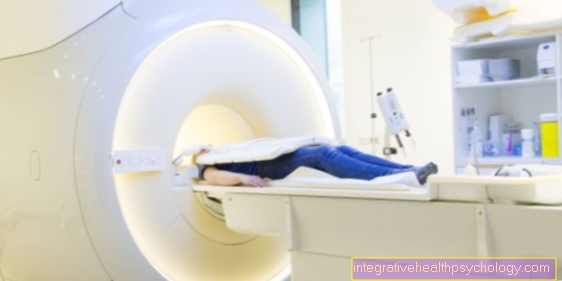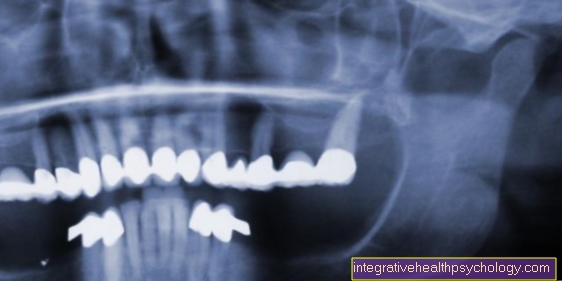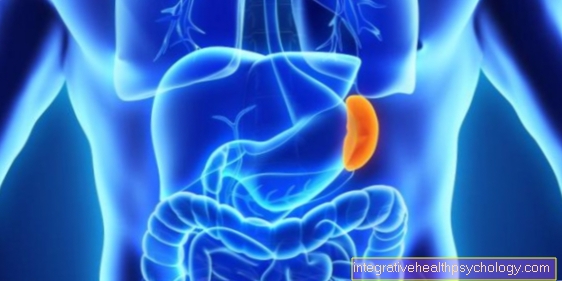Cervical myelopathy
What is cervical myelopathy?
While the term “cervical” in medicine indicates a relationship to the neck or the cervical spine, “myelopathy” describes any type of damage to the spinal cord. When speaking of cervical myelopathy, the doctor means damage to the spinal cord in the area of the cervical spine.
Cervical myelopathy can be diagnosed by the typical symptoms described by the patient (neck and shoulder pain, neurological functional restrictions, frequent falling asleep of arms and hands), a neurological examination and MRI images.
The diagnosis of "cervical myelopathy" does not initially make a statement about the cause.
Possible triggers are usually degenerative changes or herniated discs. Conservative and surgical treatment options are available depending on the cause and severity.
Read more on the subject under: Slipped disc

Causes of Cervical Myelopathy
Cervical myelopathy is usually caused by a so-called "space-consuming process".
The doctor speaks of this when the spinal canal (i.e. the canal inside the spinal column in which the spinal cord lies) is narrowed, which can manifest itself in the form of pain and other symptoms (see below).
The most common causes of this kind are degenerative (i.e. wear-like) deformations of the cervical spine or herniated discs in the cervical spine area. Tumors or trauma (injuries caused by accidents) can also be identified as causes less frequently.
Regardless of which of the diseases mentioned underlies cervical myelopathy, it is ultimately always the narrowing or damage to the spinal cord that leads to the symptoms and is responsible for the long-term sequelae of the clinical picture.
An exception to this rule are chronic inflammatory nerve diseases such as multiple sclerosis, which can also trigger cervical myelopathy. Here the spinal cord is not damaged by constriction from the outside, but rather from the inside in the form of an inflammation of the nerve sheaths.
Read more about the topic at: Spinal Cord and Multiple Sclerosis
Spinal stenosis of the cervical spine
Spinal stenosis is the most common cause of cervical myelopathy. The specialist simply means a bottleneck by “stenosis”, while the word “spinal” indicates that it belongs to the spinal column or the spinal cord. “Spinal” is a somewhat imprecise term and can refer to the spine and / or the spinal cord.
Therefore, the expression “spinal stenosis” does not initially make any statement about the actual causes and processes in the back, but merely describes a general narrowing in the area of the spine or the spinal cord.
Whether signs of wear and tear of the spinal bones, a herniated disc or a completely different disease (e.g. a tumor or an inflammatory nerve disease) are the basis of the complaints - the term "spinal stenosis" does not yet make a statement.
Read more on the subject under: Degenerative spine disease and spinal canal stenosis
Diagnosis of cervical myelopathy
First indications for diagnosis result to the expert already from the description of the symptoms by the patient. The subsequent physical examination usually confirms the suspicion of the presence of cervical myelopathy.
To confirm or refute this suspicion, radiological images of the cervical spine are taken. As a rule, an MRI examination is chosen because it delivers the most accurate images and can depict the spinal cord particularly well.
If there is a suspicion of a bony cause of the discomfort, a CT examination can also be carried out, which is better suited to depicting bony structures.
If the recordings are not clear enough or to differentiate them from other possible causes of complaint, electromyography, i.e. a measurement of the electrical excitability of the arm and leg muscles, may be necessary in some cases.
MRI of the cervical spine
The MRI examination of the cervical spine is the most important method for diagnosing cervical myelopathy. It depicts the spinal cord very precisely (which ultimately everything revolves around cervical myelopathy) and also depicts the intervertebral discs well.
Accordingly, in most cases, an MRI can be used to assess very well whether there is a spinal stenosis and, at the same time, to examine directly whether a disc disease is the cause of the constriction.
One of the weaknesses of MRI lies in its limited ability to display bony structures.
If, after a spinal stenosis is detected in the MRI, it is suspected that bony changes in the cervical spine could be the cause (e.g. because no herniated disc can be seen), an additional CT examination of the cervical spine may be necessary, which offers a better resolution of the bone representation .
These symptoms tell me that I have cervical myelopathy
First of all, it should be emphasized that cervical myelopathy can manifest itself differently depending on the severity and precise location of the damage.
For example, if there is a narrowing from the side, the symptoms can only be one-sided.
The possible symptoms include pain in the neck and shoulder area, which those affected often describe as "electrifying", i.e. similar to an electric shock.
In addition, numbness or motor impairment can occur, especially in the arms. This includes disorders of fine motor skills (e.g., those affected notice an unusual awkwardness when buttoning up shirts or lacing up shoes) as well as feelings of weakness or paralysis.
In more advanced stages, ataxia (see below, movement coordination disorders) or bladder and rectal control disorders can occur, which is often a particularly high psychological burden for those affected.
In order to be able to counteract such a course, you should not wait too long if one or more of the symptoms described are present, but rather get a specialist check-up as soon as possible.
Ataxia
Ataxia is the technical term for a disorder of movement coordination. A distinction is made between different forms of ataxia, whereby in the context of cervical myelopathy basically any form of ataxia can occur.
For example, there is extremity ataxia, in which the coordination of fine motor skills in the arms and legs is impaired, whereas in cervical myelopathy the arms are predominantly affected.
Sufferers with a trunk ataxia, on the other hand, find it difficult to sit stably; their body keeps tilting forwards, backwards or to the side. Finally, gait ataxia manifests itself in a changed, uncoordinated gait pattern.
Those affected appear shaky on their legs, sometimes even fall and sometimes find themselves exposed to allegations of alcohol consumption, which can be an enormous psychosocial burden.
What is a myelopathy signal?
In principle, all symptoms that can occur in the event of myelopathy, i.e. damage to the spinal cord, are regarded as myelopathy signals.
These include above all:
- (electrifying) pain in the neck and back area, especially when turning the head,
- as well as neurological symptoms such as numbness,
- unusual weakness of individual muscle groups,
- Symptoms of paralysis or incoordination.
In the case of cervical myelopathy, i.e. when the damage to the spinal cord is in the neck area, these myelopathy signals are mainly expressed in the neck and neck area and on the arms.
If you notice, for example, that you occasionally reach past things or that activities that require dexterity (e.g. buttoning a shirt or trousers, opening bottles) are more difficult than usual, this may be an indication of the presence of cervical myelopathy.
This, like persistent pain in the neck and shoulder area, should therefore be interpreted as a myelopathy signal and prompt a medical check-up. You should do the same if you feel unusually wobbly on your legs or repeatedly notice symptoms of numbness or weakness in your arms or hands.
Finally, the repeated falling asleep of the arms and hands at night is also to be assessed as a possible myelopathy signal.
Read more on the subject under: Myelopathy
Conservative therapy
The therapy for cervical myelopathy depends, of course, primarily on the cause of the damage to the spinal cord.
If the disease is based, as in the majority of cases, on degenerative (wear-related) changes in the cervical spine, conservative therapy is usually the first option, while in the case of a herniated disc it should at least be considered as the cause and weighed against surgical therapy .
Physiotherapy is the most important pillar of conservative therapy for cervical myelopathy. The physiotherapist mainly uses physiotherapy to strengthen the neck and trunk muscles so that they can keep the cervical spine more stable, which often leads to a significant improvement in symptoms.
Adequate pain therapy is also important: if the person concerned is too gentle on the neck due to the constant pain, the neck muscles can quickly become tense, which in turn increases the pain and so on.
In order not to let this vicious circle arise in the first place, great importance should be attached to good pain therapy from the start. When choosing pain relievers, attention should be paid to the patient's secondary illnesses and, under certain circumstances, the prescription of gastric protection drugs (e.g. Pantoprazole®).
Read more on the subject under: Proton pump inhibitors (Pantozol®)
When do you need an operation?
As described above, surgery is usually just as little an option for wear-related forms of cervical myelopathy as it is for inflammatory nerve diseases (e.g. multiple sclerosis).
Only when the degeneration is very advanced and consequently causing severe symptoms that cannot be managed conservatively can an operation make sense. The prerequisite for this, however, is that the risk of the operation is not greater than the improvement in symptoms that can be expected from the operation.
Traumas or tumors, on the other hand, usually have to be operated on. Here, too, the operation must always be preceded by a risk-benefit assessment.
In the case of a herniated disc as the cause, the decision between surgical and conservative therapy is made individually depending on the size and location of the incident as well as the age and physical condition of the patient.
Procedure of the operation
The operation of a cervical myelopathy is usually performed from the ventral (front), i.e. the patient lies on his back during the operation.
First a small skin incision is made, after which the vertebral bodies are exposed. Subsequently, parts of the bone that protrude into the spinal canal can be removed or parts of the vertebral body moved back to make room. In the latter case, small titanium plates must be inserted for attachment.
If a herniated disc is the cause of cervical myelopathy, the affected disc is removed and, if necessary, parts of the bony vertebral body as well, in order to create sufficient space for the spinal cord.
If, on the other hand, several intervertebral discs are affected at once, it may be necessary to completely remove the vertebral body lying between the intervertebral discs and replace it with the body's own bone material, e.g. from the iliac crest, to replace.
In this case, there is additional stabilization in the form of a plate screw system.
Risks of the operation
It goes without saying that myelopathy surgery is not without its risks, which is why the relationship between the expected benefits and the risks should be carefully and individually weighed before each surgery.
For specialists, however, such an operation is routine in most cases, so that the risks are usually relatively low and do not rule out an operation.
First of all, the general risks of an operation should be mentioned, which primarily include the risk of infection and bleeding. However, many cases of cervical myelopathy only require a small incision, which minimizes the risk of infection. In addition, high hygiene standards are established at German clinics, so that wound infections as a result of an operation are extremely rare.
Myelopathy operations are also generally relatively unproblematic with regard to the risk of bleeding, as there are no larger arteries in the operating area.
In addition to the risk of infection, the surgical treatment of cervical myelopathy has the possibility that the surgeon may injure the spinal cord because he is operating in the immediate vicinity of the same. It should be emphasized here, however, that this only occurs in absolute individual cases.
Is there a cure?
Here, too, a distinction must be made between conservative and surgical therapy.
Conservative therapy in the form of pain medication and physiotherapy helps many affected people very well, but is not a causal (cause-related) treatment and therefore cannot achieve a cure.
It looks different with an operation:
The removal of bony structures or the removal of a herniated intervertebral disc eliminate the cause of the cervical myelopathy and thus actually promise healing.
With one caveat: If the myelopathy has existed for a long time before the operation, it is possible that the spinal cord has already suffered permanent damage. In this case, surgery can alleviate the symptoms, but healing of the affected parts of the spinal cord is no longer possible.
Duration of cervical myelopathy
Due to the many possible causes and the wide range of degrees of severity of cervical myelopathy, no general statement can be made about the duration of the disease.
In the case of degenerative spinal changes, conservative therapy usually results in a noticeable improvement within a few weeks, although the cause is of course not eliminated and the symptoms will in principle persist.
After an operation, a rapid improvement of the symptoms can usually be assumed (apart from the wound pain, of course), but those affected should not allow themselves to be careless and protect the spine for a few more weeks.
Prognosis of cervical myelopathy
The prognosis of cervical myelopathy, like its duration, is highly dependent on the severity and cause.
Conservative therapy can achieve considerable symptom relief within weeks for most of those affected, but of course this does not change the causes of the disease.
As a result, only a few patients become completely symptom-free in the long term; the complaints often remain permanent, even if less intense.
The situation is different with surgical treatment. If the cause of the cervical myelopathy can be eliminated through an operation, the symptoms usually (unfortunately but not always) improve surprisingly quickly, and some patients are even completely symptom-free immediately after the operation.
In any case, it is important to note that the long-term success of the operation also depends to a large extent on the aftercare. Taking part in check-ups is just as important as following the surgeon's instructions with regard to rest time and subsequent muscle building through physiotherapy.
Degree of disability
For cervical myelopathy to be classified as a disability, the law first of all requires that the disease entails “impairment of participation in life in society”.
The classification in a degree of disability (GdB) then depends on the severity of the impairment.
In the case of permanent or repeated moderate movement restrictions and pain that (as in the case of cervical myelopathy) are limited to the cervical spine, a GdB of 30 can usually be assumed.
Only if other parts of the spine are also affected are higher GdB measured. Please note: If there are other functional restrictions in addition to the myelopathy that result in a GdB, an overall GdB is formed from the individual GdB.
However, this does not result from simple addition, but from a special offsetting of the individual GdB.








.jpg)




















